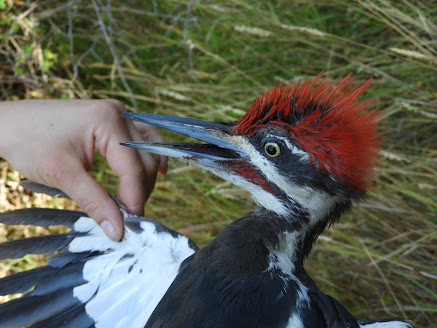 |
| An absolutely adoooorable Least Flycatcher! (David Bell) |
The end of August is when better turnover of migrating songbirds occurs, a time when we start to see and catch more! We expect this uptick in activity as we approach the fall months and it’s always pleasant to see when the passerines start flowing!
Numbers are beginning to increase for us, and fall is definitely in the air. Both of our stations are catching more birds each day compared to previous weeks, and daily species + individual totals are on the rise. Total number of new birds banded this week at Rocky Point was 204 (vs 183 the week before), and at Pedder Bay we banded 206 new birds (vs 110 the week before).
Vireo and Flycatcher counts are gradually on the climb, and as for Warbler numbers, they are skyrocketing! The presence of Yellow Warblers is very evident right now. This week we’ve been recording anywhere from 20 individuals, all the way up to 75 individuals at both stations on daily estimated totals. Compare this to last week when we were only seeing ~3-10 individuals. Yellow Warblers are not the only Parulidae increasing at both sites; daily counts of individual Orange-crowned Warblers, Townsend’s Warblers, and (my personal favourite) Black-throated Grey Warblers are steadily rising too as fall progresses. We caught our first Townsend’s Warblers of the season (two) at Pedder Bay this week!
 |
| What a gorgeous Townsend's Warbler! - 1 of 2 caught (Samuelle SP) |
With this increase of passerine activity comes the prospect of finding a rare songbird or two. Usually these rare songbirds are encountered around the stations (either at Rocky Point or Pedder Bay), but occasionally we get lucky and find a rarity in one of our mist nets.
This week at our Rocky Point station we got our first taste of interior-rarity-action when we banded a Hatch-Year Least Flycatcher! This tiny, subtly plumaged, Empidonax species is a common summer breeder across the vast majority of Canada and parts of the United States, but is rarely found along the western edge of BC. On August 23rd, when we caught it, we actually observed two other individuals (so at L E A S T three individuals were around the station that day). Two were hanging around the nets and eventually one ended up hawking itself right into the upper section of net 8, giving RPBO it’s 4th (ever!) banding record of this species. This was a long awaited banding tick for one of our interns (Liam), who up until then, had not gotten to band any new species. A well deserving species to get for his first banding tick of the season!
 |
| One more photo of the Least Flycatcher (Liam Singh) |
Another species we caught that's not quite as rare as the Least Flycatcher but still equally as thrilling to band, was a Northern Waterthrush! We caught this bird at our Pedder Bay station and it represents only the 6th banding record for Pedder Bay (total between both sites is 29).
 |
| Northern Waterthrush (David Bell) |
Also at the Rocky Point station, we caught another exciting species, a Marsh Wren! Like the Northern Waterthrush, we typically catch one a year.
 |
| Lil' baby Marsh Wren looking cute as ever (Liam Singh) |
*Rocky Point station: (RP)
*Pedder Bay station: (PB)
Other birds of interest we have banded this week between the two stations included:
A Black-throated Grey Warbler (RP),
Our second Cooper’s Hawk of the season (PB),
Two Hammond’s Flycatchers (PB),
Another Barn Swallow was caught (PB),
Two Red-breasted Sapsuckers (RP)
Nine Western Tanagers (PB)
 |
| Black-throated Grey Warbler (Liam Singh) |
 |
| Red-breasted Sapsucker (Liam Singh) |
 |
| Western Tanager (Liam Singh) |
Weekly stats for both stations can be seen here:




































